There’s an old joke that America is on a tilt and everything that’s a little loose rolls into California.
That aphorism might have to be updated to reflect that the country is tilting due to the weight of the new and expanding West Coast museums, and any artwork not nailed down tightly will likely end up there. Not as pithy, perhaps, but possibly more accurate if one considers such examples as the inspiring 120,000-square-foot The Broad, a brand new, uber-hip contemporary art museum in downtown Los Angeles.
Museums throughout the world are expanding and new ones are being constructed at a stunning rate, drawing on the kind of magnanimity and enthusiasm with which western cities once threw up colossal cathedrals. And for similar reasons: the core of the modern city-center that generates meaning has moved from the religious to the secular.
Now the art world, for better or worse, has become the locus of thought and reflection. This shift, in turn, has given rise to dramatic new buildings by edgy architects that announce a city’s maturity.
San Francisco just reopened the seriously expanded SFMOMA (San Francisco Museum of Modern Art) with a bewildering 10 stories and 235,000-square-foot addition. This brings the museum total to 460,000 square feet, in a town of only 900,000 people. The biggest cathedral indeed.
Southward in Los Angeles the city-block size LACMA (Los Angeles County Museum of Art), shared with the La Brea Tar Pits, is updating the Oscar Niemeyer building with even more real estate in a sprawling design by Swiss architect Peter Zumthor that builds over Wilshire Avenue and straight up into a tower of unspecified height.
.
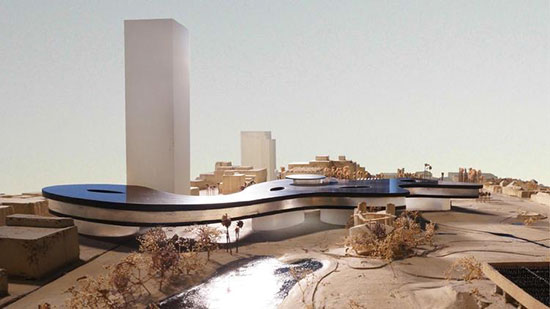
LACMA proposed expansion by architect Peter Zumthor.
.
Further to the south, San Diego has Iinished the design phase of a new 30,000 square foot museum in La Jolla by New York’s Selldorf architects.
.
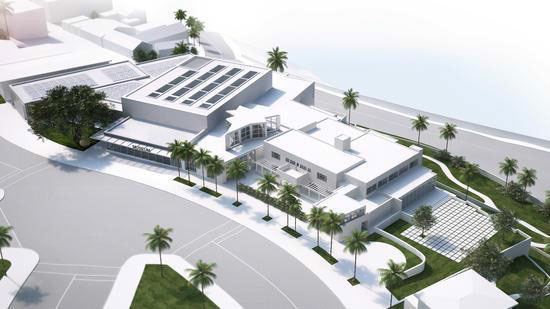
Maquette of MCASD's planned expansion in La Jolla. Selldorf Architects,
.
In addition to these huge public undertakings, the state of California now includes a number of vast private art museums, including the two built by industrialist J. Paul Getty and his heirs, and now The Broad in downtown Los Angeles, compliments of real estate tycoon Eli Broad and his wife Edythe.
The Broad art museum is built across the street from the prominent Museum of Contemporary Art, Los Angeles—which itself has now expanded to a dizzying three locations— and next to the shimmering Frank Gehry designed Walt Disney Concert Hall. All three are located in a formerly abandoned and seedy area dubbed DTLA for downtown Los Angeles (where this writer once lived) and now known appropriately as the Arts District.
.
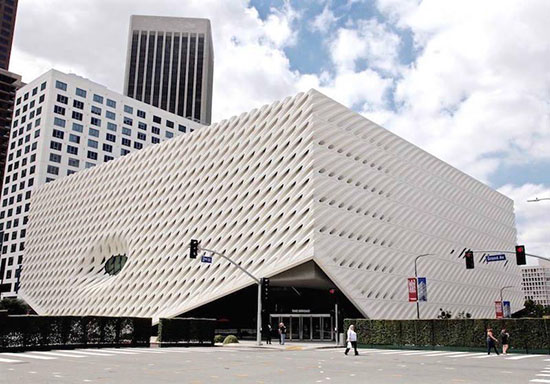
The Broad by Diller ScoDidio + Renfro and Gensler architects.
.
Those who wonder whether the formerly disaffected population of Los Angeles can sustain interest in a vast offering of culture need look no further than the standby lines for tickets to enter the The Broad stretching around the block every morning. Bear in mind that attendance figures are based on both the standby lines and all the free online tickets that are grabbed weeks in advance of a planned visit. If I hadn’t huffed and puffed that I was a credentialed art writer, I would have been guessing the museum’s contents from the curb.
.

Standby line outside The Broad.
.
The Broad opened last September with a corrugated building designed to showcase the 2,000-piece collection of the Broads. Director Joanne Heyler curated the inaugural exhibition, selecting 250 works by more than 60 artists, including John Baldessari, Jasper Johns, Robert Rauschenberg, Ed Ruscha, Roy Lichtenstein, Jeff Koons, and Kara Walker.
Built as a three-story museum by New York architects Diller Scofidio + Renfro in collaboration with the California firm Gensler, it boasts 50,000 square feet of exhibition space. The third level seems to be the main floor, with 23-foot-high ceilings and its open 35,000 square feet gallery space with 318 skylights.
.
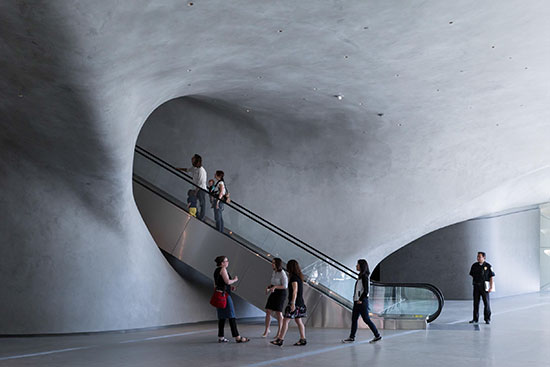
Lobby of The Broad.
.
The second floor is not available to the public but one is allowed to peek into its cavernous storage space from a fixed pane in the stairwell and view stainless steel racks that contain some of the best painting produced in the past half-century. This floor is referred to in-house as the Broad’s “world-wide lending library.”
The collection is highly focused, expectedly, as it flows from only two pairs of eyes and contains mostly idea-based art from New York galleries. The experience of the museum is, on the one hand, perfect, and is also somewhat wanting, as scrappier work rarely makes it into the shiny surface works favored by many of the commercial galleries feeding the auctions.
There was a time when anything shiny used to be derided as “commercial art,” but that term has ceased to exist. Visitors should not expect to see, for example, installations such as Walter De Maria’s Earth Room, with three feet of dirt, or Ann Hamilton’s privation and excesses, wherein she covers a floor with pennies and honey.
No, this is the other art world, the moneyed Sotheby’s and Christies’ art world where clean hermetic objects are swapped with what feels to me like the emotional investment of cotton futures.
.
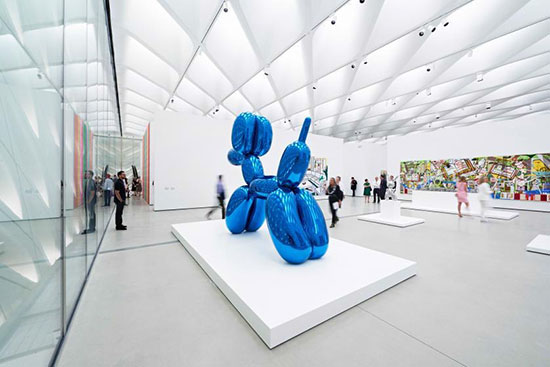
Jeff Koon's "Balloon Dog" in the foreground.
.
Shortly after opening with the primary program of works from The Broad’s collection, the museum announced its first special show: an extensive survey of East Hampton based artist Cindy Sherman that will fill the ground floor. The exhibit, “Cindy Sherman: Imitation of Life,” opens June 11 and will run through October 2, 2016.
This will be the first major survey of Sherman’s work in Los Angeles in nearly 20 years, and the more than 100 works in the exhibition will be primarily drawn from The Broad’s collection. The ground floor windows of the museum were papered over to mask the installation in progress when I was there.
Ms Sherman’s unique work of photographing herself in other personas, typically derived from the media, fits perfectly into a chapter of critical theory that believes our psyches are constructed of layers of random media figures. These include heroes, ingénues, starlets, sports stars and especially characters encountered in advertising. The movement that examined these phenomena is known as The Pictures Generation and dominated the art scene for a decade after neo-expressionism waned.
Cindy Sherman’s show will undoubtedly be outstanding, but will now be one among dozens that will open in California in the same week. In “Annie Hall,” Woody Allen joked of Los Angeles that “the only cultural advantage is being able to make a right turn on a red light.” In 1977, before “right on red” became the national norm, that was a good laugh. Now that quip might beget a puzzled look: by sheer volume and dollars alone, the West Coast is prepared to eclipse New York as an art center.
The history of the epicenter of art and culture is the history of this center moving west. A center appeared in lower Nile Valley in 3000 BCE that flourished with Egyptian art. Then the center headed north and west to Greece in the 5th and 4th centuries BCE for the Greek enlightenment.
Centuries later the center moved further west to Italy during the Renaissance. Paris, west of Rome, was the center of the arts and culture for half a century before it leaped west once again to New York after World War II. It seems fitting that this migrating center seems bent on continuing its path west to California; God knows they have the buildings for it.
_______________________________
BASIC FACTS: The Broad, 221 S. Grand Avenue, Los Angeles, CA 90012. www.thebroad.org.
Reserve tickets are mandatory.
________________________________
Copyright 2016 Hamptons Art Hub LLC. All rights reserved.
